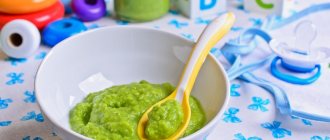When it is necessary?
Even if the mother has a small amount of milk, the baby should still be attached to the breast and strive to prolong breastfeeding as much as possible.
To avoid complications for the baby’s health, parents should discuss in detail all issues related to artificial feeding (diet, choosing or changing formula, introducing complementary foods, etc.) with a pediatrician or pediatric nutritionist.
Every mother should understand that even the most perfect milk formula is not equivalent in composition to human milk. It is impossible to replace human milk - its properties are unique.
Therefore, despite the intricate “formulas” of breast milk substitutes, which only a doctor can understand, parents need to have an idea of what milk formulas are.
Why do bottle-fed babies need water?
- Thanks to additional drinking, the baby will not only absorb nutrition better, but will also not suffer from constipation (a common problem in bottle-fed children). With a lack of fluid in the body, stool becomes drier and denser, which causes difficulty in removing it.
- Water is also a good helper for hiccups; it relieves laryngeal spasm and fights the cause of the condition. And in order to avoid a recurrence of the problem, it is necessary to warm the child, take him in an upright position (if the baby was in a hurry during feeding and air got into the digestive system) and calm him down (in the case when hiccups occur as a result of a stressful situation and overexcitation).
- When babies have a fever, they should also be given water to drink. It alleviates the condition and stabilizes the temperature, thanks to it everything unnecessary is removed from the body.
- When a child suffers from vomiting or diarrhea, he especially needs water, since the body quickly and sharply loses a lot of fluid and needs to compensate for the lost moisture. In these cases, it is worth giving the baby water as often as he wants.
- There is a very controversial claim that water is supposedly beneficial for jaundice in newborns. However, doctors say that since jaundice occurs due to increased levels of water-insoluble bilirubin in the blood, additional water will not help alleviate the condition and remove this substance.
Types of Infant Formulas
Since the product closest in composition and properties to human milk is cow's milk, it is the basis of milk formulas for healthy babies. There are also goat milk-based formulas (such as Nanny) and soy-based formulas (for children with milk protein allergies).
You should know that there are big differences between cow's milk and human milk. In cow's milk, the content of protein, calcium, potassium, sodium and other mineral salts is much higher than in women's milk, and the level of carbohydrates, a number of fatty acids and vitamins, on the contrary, is lower. The degree to which cow's milk approaches the composition of women's milk varies. It determines the type of mixture, which is always indicated on the packaging.
All “substitutes” are divided into adapted and partially adapted.
Mixed feeding: when supplementary feeding is required and in which cases not
When preparing the expectant mother for childbirth, obstetricians and then neonatologists tirelessly repeat that only mother’s milk will become a source of nutrients and vitamins for the baby, a natural barrier against the aggressive external environment. But sometimes you have to use mixed feeding for a newborn.
Screenshot: Propaedeutics of childhood diseases. Textbook for medical universities/Ed. ON THE. Geppe. - M., 2008: UGC
This is one of the options for organizing a baby’s nutrition, which pediatricians resort to in exceptional cases. In their article, V. Kulichkov and E. Goreva cited statistics according to which almost 44% of infants receive breast milk from the moment of birth and during the first year of life. Only 14% of babies are mixed-fed. The percentage varies depending on the time during which infants receive formula supplementation along with mother's milk: 71% in the hospital, 15% in the first month, and 14% during the first year.
Let us tell you in more detail what this method of feeding newborns is, when and to whom doctors recommend using it.
Mixed feeding is a type of nutrition in which the baby receives both mother's milk and an adapted formula. Doctors prescribe it based on the physiological indicators of the newborn and mother. Let's look at specific cases from my practice:
- Supplemental feeding in the maternity hospital - 10% weight loss.
In the delivery room, the baby (weight - 3 kg 300 g) was put to the breast, he received colostrum. The next day, the mother often put the baby to the breast, but the milk did not come, the newborn did not eat enough and cried. On the third day, during control weighing, he weighed 2 kg 900. The weight loss was 400 g, which was more than 10% of birth weight.
- Prescription of supplementary feeding 14 days and a month after birth.
- During patronage, the pediatrician found that during two weeks of staying at home after being discharged from the maternity hospital, the newborn gained 200 g in weight, with the norm being 125–150 g per week. A survey of the mother showed that she had very little milk. Frequent attachments did not contribute to the arrival of breast milk. The child behaves restlessly and cries often. The doctor prescribes a formula that should be used to supplement breastfeeding.
- When weighed during an examination at the clinic, the child, who was one month old, was 500 g underweight. The pediatrician recommended mixed feeding.
Photo: Ladodo K., Druzhinina L. Encyclopedia of baby food. - M., 2008: UGC
In the cases described, supplementary feeding is a prescription motivated by objective indicators of the infant’s growth and development. However, young mothers sometimes decide to introduce formula on their own or on the recommendations of more experienced older women or friends. As a result, natural feeding is harmed, because the newborn begins to be lazy and refuses to suckle, because he receives nutrition in a simpler way - from a bottle. For the mother, this is also fraught with problems: stagnation of milk, the need to express, attachment to bottles and sterilizers, etc.
When should you not resort to mixed feeding:
- if the child grows normally and gains weight according to standards;
- if the baby does not maintain the regime;
- to prolong a newborn’s sleep (especially at night);
- if you doubt the nutritional value of your own milk.
There is also a category of young mothers who are terrified of giving sublimated breast milk. This was facilitated by myths according to which formula-fed children lag behind their peers raised on breastfeeding in mental and mental development.
This has not been confirmed by any research and is contrary to common sense and the physiology of newborns. Therefore, follow only the recommendations of qualified specialists in this matter.
Can pregnant women have kvass: the benefits and harms of the bread drink, contraindications
Adapted Substitutes
Most closely related to human milk. Adaptation of the composition of milk formulas is carried out according to protein, fat, carbohydrate, vitamin and mineral components - the main components of milk.
The protein component of breast milk substitutes is of greatest importance for the baby. In most adapted mixtures, it is represented by casein (the main protein of cow's milk) and whey proteins (dominant in human milk) in a ratio of 40:60 or 50:50. Whey proteins form a more delicate curd in the baby's stomach than casein, which ensures a higher degree of milk absorption.
A group of adapted milk formulas in which cow's milk protein, casein, dominates (its share is 80%) is called casein formulas (mixtures). Casein is subjected to special processing to increase its digestibility. The composition of the necessary components of casein formulas is also as close as possible to the composition of human milk, so they can be used in the nutrition of children from the first days of life.
In all adapted milk formulas, the fat component is processed - milk fat, which is completely or partially replaced with a mixture of vegetable oils (sunflower, corn, soybean, rapeseed, coconut, palm). Lactose (less commonly, dextrin-maltose) is most often used as a carbohydrate component.
The mineral composition of cow's milk is also significantly changed: the content of calcium, potassium, sodium is reduced, and iron, zinc, copper, iodine, and fluorine are added. The necessary vitamins (A, C, D and others) are added to the mixture.
Some adapted human milk substitutes are enriched with the amino acid taurine, which is necessary for children in the first weeks and months of life for the formation of visual organs and the brain; vitamin-like compounds - carnitine, which promotes the formation of fatty acids, inositol; nucleotides that affect immunity.
Adapted mixtures are dry and liquid (ready-to-use). The latter are easier to use: they do not need to be restored, which protects against possible errors in diluting dry mixtures. In addition, during the production of dry mixtures, some useful properties of a number of components that are preserved in liquid mixtures are lost. However, the range of adapted liquid mixtures is small. These include, for example, AGU-1, produced by the Children's Dairy Products Plant (Moscow).
Mixtures come in fresh and fermented milk. In the production of fermented milk mixtures, various starter cultures are used - kefir grains, bifidobacteria and acidophilus bacillus. But they are recommended for children from 2-3 weeks of age, since in newborns, and especially in premature babies, they can cause or increase regurgitation.
Water for newborns
Pediatricians agree that infants do not need extra fluids. But what if the baby eats formula milk? Water is vital for a bottle-fed baby.
Table of contents
|
There are a number of situations where additional moisture improves the well-being and mood of a newborn.
It is important to know how much water children of different ages need and what water to use for supplementary feeding.
How much water does a child need?
At the age of 0-2 months, the baby should drink 500-700 milliliters of water.
From two months to six months - 1 liter, from 6 months to a year - 1200 milliliters.
This is the total amount of water, taking into account mixtures and complementary foods.
The amount of fluid a baby needs also depends on different conditions. For example, on air temperature.
• If it is hot in the apartment or outside, give liquid once every 30 minutes.
• At temperatures below + 20, additional moisture will most likely not be needed. The child will have enough of what is contained in the mixture.
• At a comfortable temperature - +24 degrees - it is enough to give the baby one drink between feedings.
Don't forget that standards are relative, and each child can drink more or less.
His thirst can be affected by the characteristics of the body, the time of year, the climate, and the density of the food he receives.
Given the small volume of a child's stomach, it is better not to offer him water just before feeding.
Otherwise, he may eat less than he should and remain hungry.
Why give your baby more to drink?
• Formula milk contains more protein than breast milk. A lot of liquid is needed to break it down, so artificial babies need to be supplemented from birth. Water is given regularly in between doses of the mixture.
• Water for newborns is the best remedy for hiccups. It eliminates spasms and relieves discomfort. You also need to take care that the hiccups do not start again.
It can be caused by hypothermia, swallowing air during feeding, or stress. Accordingly, you need to warm the newborn, hold him upright in your arms or caress him so that he calms down.
• Formula-fed babies often experience constipation. Water is an excellent way to prevent this problem.
With a lack of water, stool becomes too dense, making bowel movements difficult. After drinking, the baby will get rid of excess and feel better.
• Dehydration is dangerous for a newborn. It can be caused by loose stools or vomiting. Dehydration can be identified by rare urination (up to 20 times a day), sunken fontanel and dry lips.
In such situations, it is imperative to replenish water reserves in the body. Therefore, supplementation should be more frequent and plentiful.
• Fever is another important reason to offer your child more water. It will help reduce the temperature and rid the body of excess substances.
• It is believed that water helps with jaundice. However, experts refute it. This disease is associated with an increase in the amount of bilirubin in the blood.
And it does not dissolve in water. This means that the liquid will not affect its removal from the body in any way.
• Introducing complementary foods should also be accompanied by additional fluids. Especially if the child tries hard treats.
• Monitor your baby's behavior. If he smacks his lips or reaches for water, he may be thirsty.
Temperature and suitable containers
First, you should heat the water to body temperature – 36 degrees. Then gradually reduce it, bringing it to room temperature - 20 degrees (when the baby is 3 months old).
Water can be offered from a spoon or a separate bottle. It is better that the latter is designed specifically for water.
Useful tips for mothers: BABY UP TO ONE YEAR
A single portion should be very small. It is better to give the child something to drink several times than to forcefully try to give the child large amounts of water to drink.
What kind of water is suitable for newborns?
There are quite a lot of options. The main thing is that it is not ordinary tap water. It is dangerous to drink even for adults, not to mention small children.
• The best option is baby water for newborns, which is sold in any grocery store or pharmacy. The label will help you choose water that is suitable for age and composition.
The advantage of this option is the presence of vitamins and microelements, as well as the safety of the plastic bottle itself.
• Use springs or artesian springs. But only if you are sure of their purity.
• If water is needed urgently, and only regular still water is available, you can give it too. As a last resort, you can use carbonated drinks, after removing all gases.
To do this, just shake the bottle and leave it open for a while. When the gases come out, offer it to the baby.
• Mommy can use water from a home filter. In this case, you need to strictly monitor the frequency of its change.
• Boiled water is often used, but this is not the best option. There is no benefit to it, because after boiling, not only harmful, but also beneficial microorganisms are destroyed.
• You can quench your baby's thirst with special herbal teas. They also have a medicinal effect. At 1 month and even earlier, offer the newborn dill water.
It will help with colic. If a child is prone to excessive agitation, mint or chamomile infusion will be useful. For colds, offer your baby linden.
It is better to use industrial products in bags or granules. This way there is no risk of making a mistake in proportions. In addition, they are prepared under strict control.
• It is strictly not recommended to add sugar to water. It is harmful to the newborn and only causes greater thirst.
If a child doesn’t drink, it means he doesn’t want to drink yet. Just wait a little.
Doctor Komarovsky's opinion
The famous pediatrician has his own point of view regarding supplementation of artificial supplements.
According to the doctor, if the child is healthy but refuses additional fluids, this is quite normal.
Komarovsky recommends completely avoiding boiled water.
It is better to use spring or well water, mineral water or raisin infusion. The decoction is easy to prepare.
The raisins are washed, then a tablespoon of dried fruit is brewed in 250 milliliters of boiling water. After cooling the drink, offer it to your baby.
The pediatrician notes that the amount of moisture the body needs depends on its loss. And moisture is lost when a person sweats or breathes dry air.
• If the house is warm and dry, and the child is covered from head to toe, he will lose a lot of fluid. This means he needs to drink more than normal.
• When the temperature in the room is no more than + 20, the child will drink little. Or he will refuse additional fluids.
• If the thermometer shows +24, the baby will drink about 100 milliliters per day.
When a newborn does not have enough fluid, he becomes capricious. Food is poorly processed, so the tummy hurts and sleep is disrupted.
With regular supplementation, these problems disappear.
But this is only relevant for hot rooms. When the apartment has the correct temperature (+ 19 degrees) and humidity (up to 70%), additional drinking is not necessary.
The pediatrician emphasizes that if the baby is constantly thirsty, create comfortable conditions, and everything will be fine.
- about the author
- Recent publications
Arina Nagovitsyna
author of the publication (site editor)
JOURNALIST Higher education: Faculty of Journalism and Mass Communications
Arina Nagovitsyna recently published (see all)
- What can a child at 3 months - 09/12/2019
- What a 2 month old baby can do – 09/11/2019
- Which formula to choose when mixed feeding - 09/10/2019
Partially adapted milk formulas
Less close to the protein composition of human milk. Cow's milk protein is less processed than in adapted formulas. Instead of lactose, sucrose or starch is often added to them.
They can also be dry and liquid, fresh and sour.
Partially adapted formulas essentially include “follow-up formulas” intended for children older than 5-6 months. They usually have the number 2 next to the name, for example, “Agu-2”, “HiPP-2”, “Samper Baby-2”. The content of protein, iron and energy value of “follow-up formulas” is higher than in “starter” human milk substitutes, which meets the needs of children in the second half of the year.
Rhythm of supplementary feeding
There is no fundamental difference in how to organize mixed feeding of an infant, but there are two tactics:
- After each breastfeeding, give the baby formula (the amount calculated using the above formula, divided by the approximate number of feedings per day).
- One or more feedings per day should be done entirely with artificial formula.
The choice of tactics depends on the family’s lifestyle and the baby’s preferences, which should also not be ignored.
Before full feeding with an artificial formula, it is necessary to gradually, starting with half a teaspoon, accustom the child to new food, carefully monitoring the reaction. If on the second day after introducing a few drops of the mixture allergic reactions did not appear, then the mixture can be safely introduced into the diet.
What to consider when choosing a mixture?
- The younger the child is, the more he needs the most adapted breast milk substitutes. Therefore, it is better to give just such mixtures to babies from 0 to 6 months.
- In the first three weeks of a child’s life, fresh formulas are better suited, since fermented milk formulas can cause or increase regurgitation; then it is more advisable to combine fresh and fermented milk mixtures in a proportion of approximately 50 to 50 percent.
- In no case should a child under 5-6 months be prescribed “follow-up formulas” or unadapted fermented milk mixtures.
- In each case, individual tolerance of the mixture is important. There are cases when a child is allergic to one of the modern most adapted mixtures, but not to another of this generation.
Formula for an infant must be prescribed by a doctor. Any decision made independently can have unpleasant consequences for the baby’s health.
Choosing water for your baby's extra drink
Of course, children are completely prohibited from giving tap water, even filtered water. It’s better not to risk it and buy special bottled water for babies; it can be found in any pharmacy or even a regular store. It indicates the baby’s age and mineral composition. Special baby water often contains the necessary vitamins and microelements that are necessary for a growing body. And the bottles are made from plastic that is completely safe for health.
The ideal solution is artesian or spring water from a clean source. If it is impossible to purchase special baby water, any bottled water without gas will do. Remember that too mineralized water is unacceptable for babies; it is better to give preference to neutral compounds. Therefore, read the labels carefully.
For those who use high-quality water filters, the filtered liquid option is also suitable. As a last resort, you can take boiled water; it does no harm, but it has little benefit. The reason is that boiling destroys both beneficial salts and harmful substances. Therefore, such water is practically meaningless; it only quenches thirst. But herbal decoctions are quite suitable instead of water, but you can’t take any of them, but only those that are specifically intended for children. If children have colic, dill or fennel water will do; if the baby is overexcited, then make an infusion of chamomile and mint. But for a child who has a cold, a linden infusion is suitable. Teas in granules are especially convenient for children; they are easy to use and completely safe for a newborn.
You cannot make water sweeter for children. Yes, kids drink this drink better, but sugar only increases thirst. Sugar is also difficult for the body to digest and overloads it. If a child currently refuses to drink, it means that he does not need it now. And do not try to add sugar and force him to drink; it is better to wait until the child wants to drink on his own.
Reasons for transferring a child to mixed feeding
The main reasons for transferring a child to mixed feeding are:
- insufficient production of breast milk by the baby's mother;
- course of medications;
- woman and child going to work.
It is the mother's lack of milk that is the main reason why the child begins to receive supplementary feeding in the form of formula.
There are clear criteria to help determine milk deficiency:
- The child decreases the number of urinations throughout the day. If a baby pees less than seven times, then we can talk about a lack of breast milk.
- The baby becomes constipated. But this symptom can be considered an indicator of the baby’s malnutrition only in combination with a reduction in urine output.
- The transition to a mixed type of feeding will be justified if the child gains less than six hundred grams per month in the first six months of life. But if a decrease in gain is recorded in the fifth or sixth month, then it is recommended to introduce the first complementary foods a little earlier.
- A sign of milk insufficiency can be poor breast fullness, as well as a decrease in the volume of expressed milk.
Physiological changes in stool during supplementation
A child receiving supplemental feeding in the form of formula milk gains weight almost the same as his breast-fed “colleague”. But the stool of such children is different.
The stool of a mixed-fed baby is characterized by a reddish-brown color and has a slightly foul odor, reminiscent of the smell of adult feces. The consistency of the stool changes from semi-liquid mushy to thicker, resembling plasticine. The frequency of bowel movements becomes less frequent. This is normal because the child's digestive system is confronted with foods that are unnatural to him.
At first, there may be white lumps in the baby's stool. Most likely, these are fragments of undigested food: the enzymatic system did not have time to adapt to the changed diet.
That is why the smell and color of the stool of a mixed-fed baby differs from the stool of babies who receive exclusively breastfeeding. A few days after the introduction of supplementary feeding, the stool should become homogeneous, but it will never become similar to infant stool.











